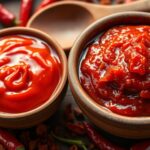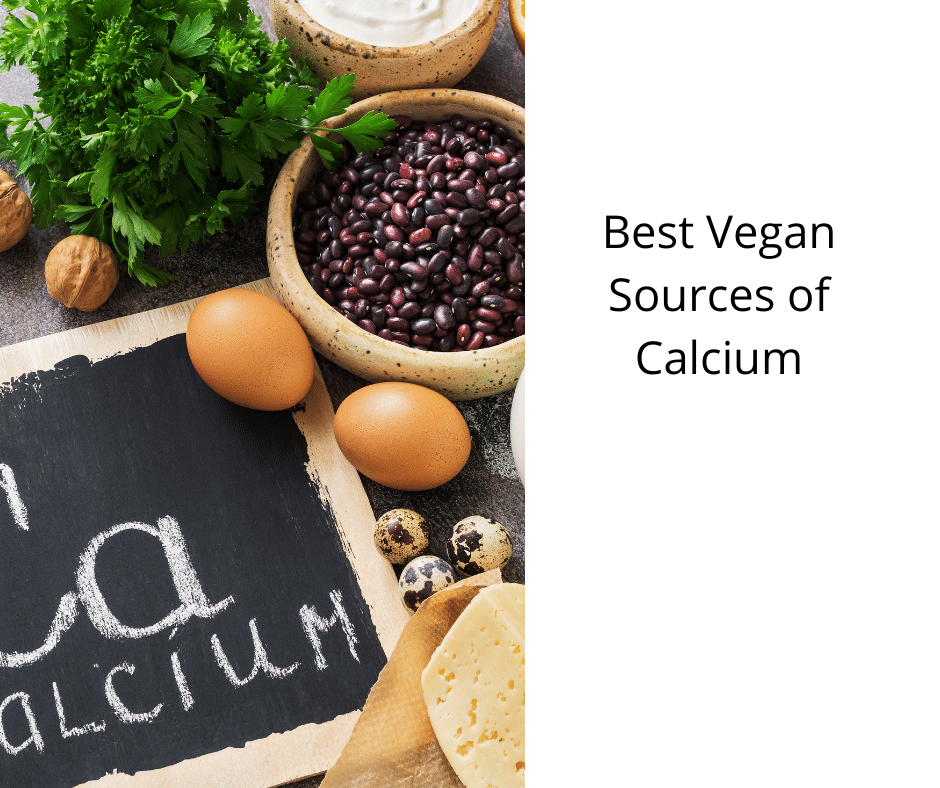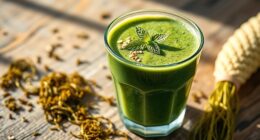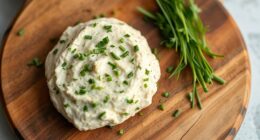To master spicy vegan cooking with global sauces, start by exploring regional spice blends like Indian garam masala or North African ras el hanout to add authentic depth. Pair these with sauces such as harissa, Sriracha, or Thai chili sauce to build bold flavors. Balance heat with acidity, sweetness, and creaminess to create harmonious dishes. Continue discovering new combinations, and you’ll open a vibrant world of flavor that transforms your plant-based meals.
Key Takeaways
- Incorporate regional spice blends like garam masala or ras el hanout to add authentic, complex flavors to vegan dishes.
- Use diverse global sauces such as harissa, Sriracha, or Thai chili to customize heat levels and flavor profiles.
- Balance spiciness with acidity, sweetness, or creaminess using lime juice, maple syrup, or coconut milk.
- Experiment with layering different spices and sauces to create rich, vibrant, and globally inspired vegan recipes.
- Start with small amounts of spices and sauces, then adjust to achieve desired heat and flavor harmony.

Ever wondered how to elevate your vegan meals with bold, fiery flavors? The secret lies in exploring regional spice blends and understanding how to craft the perfect vegan sauce pairings. These elements are key to transforming simple ingredients into vibrant, mouthwatering dishes that pack a punch. By embracing the diverse world of global sauces, you can add depth and excitement to your plant-based cooking, creating meals that are as flavorful as they are satisfying.
Start by familiarizing yourself with regional spice blends. Each culture offers unique combinations that can instantly boost the heat and complexity of your dishes. For example, Indian garam masala and ras el hanout from North Africa bring warm, aromatic notes, while Mexican adobo and chili powder introduce smoky, fiery elements. Thai curry powders and Chinese five-spice offer a different spectrum of flavors, blending sweetness, warmth, and heat. Incorporating these blends into your recipes doesn’t require much effort — a teaspoon of a spice blend can elevate a stir-fry, stew, or tofu scramble with layers of authentic taste. Experimenting with regional spice blends allows you to explore global cuisines while keeping your dishes vegan and vibrant.
Equally important is mastering vegan sauce pairings. Sauces are the backbone of spicy vegan dishes, adding moisture, flavor, and heat. Think beyond basic hot sauce — explore options like harissa for North African flair, Sriracha for a spicy kick, or a fiery Thai chili sauce to add a punch of heat. Coconut milk-based sauces can mellow the spice while adding creaminess, perfect for curries. For a tangy, spicy touch, mix in lime juice and fresh herbs like cilantro or basil. These vegan sauce pairings are versatile and can be tailored to suit the intensity of the spice blend you’re using. They also help balance flavors, ensuring that each bite is a harmonious blend of heat, acidity, and richness.
To truly master spicy vegan cooking with global sauces, think about balancing heat with acidity and sweetness. A splash of vinegar or a squeeze of lime can brighten up a dish, while a touch of maple syrup or agave can tame overly intense heat. You’ll find that layering flavors through regional spice blends and thoughtful sauce pairings turns everyday ingredients into exciting, fiery creations. Keep experimenting with different combinations, and soon you’ll be creating bold, spicy vegan dishes inspired by cuisines from around the world — dishes that excite the palate and bring a global touch to your plant-based meals.
Frequently Asked Questions
Can I Substitute Non-Vegan Ingredients in Traditional Spicy Sauces?
Yes, you can substitute non-vegan ingredients in traditional spicy sauces with non-vegan ingredient substitutions. To do this effectively, you’ll want to contemplate flavor profile adjustments—like using plant-based creams or oils to mimic dairy or meat-based flavors. Experiment with ingredients like coconut milk, soy sauce, or smoked paprika to replicate depth and heat. This way, you’ll maintain the authentic spice and richness while keeping your dish vegan.
How Do I Adjust Spice Levels for Sensitive Eaters?
Think of your dish as a symphony – you control the volume. To adjust spice levels for sensitive eaters, start with a mild flavor and gradually add more heat, tasting as you go. Use taste balancing techniques like adding dairy-free milks, coconut milk, or sweeteners to mellow the heat. This way, you create a balanced, enjoyable experience for everyone without overwhelming their palate.
Are There Gluten-Free Options for Global Spicy Sauces?
Yes, there are gluten-free options for global spicy sauces. You can choose sauces made with gluten-free ingredients like tamari instead of soy sauce or use naturally gluten-free spices. Look for vegan sauce alternatives labeled gluten-free, such as sriracha made without wheat or chili pastes that rely on rice and legumes. Always check ingredient labels to guarantee they meet your dietary needs, so you enjoy flavorful, spicy dishes without gluten worries.
What Are Some Vegan Protein Pairings With Spicy Sauces?
You can pair spicy sauces with vegan proteins like tofu stir fry and chickpea curry. Tofu absorbs flavors well, making it perfect for spicy global sauces, while chickpeas add texture and protein. Try coating tofu in a spicy sauce before stir-frying or mixing chickpeas into a curry for added heat. These combinations boost flavor and nutrition, creating satisfying, spicy vegan dishes.
How Long Can I Store Homemade Spicy Vegan Sauces?
Your homemade spicy vegan sauces can stay fresh for about a week in the fridge if stored properly. Think of it as a race against time—use airtight containers to keep out moisture and contaminants. For longer shelf life, consider freezing small portions; just remember, sauces typically last 3-6 months in the freezer. Always check for signs of spoilage before using, and follow storage tips to keep flavors vibrant.
Conclusion
Think of your kitchen as a vibrant garden, where each global sauce is a seed waiting to bloom. With your spicy vegan creations, you’re nurturing this garden, coaxing flavors to flourish and dance together. Every stir and simmer is like tending to your plants, fostering growth and harmony. Embrace the journey, and soon your dishes will burst with the colorful, fiery essence of a well-tended paradise—alive, thriving, and endlessly inspiring.
Ilana has been a vegan for over 10 years. She originally made the switch for health reasons, but soon found herself becoming more and more passionate about the ethical and environmental implications of a vegan lifestyle. Ilana is the author of The Graceful Kitchen, a blog all about veganism. She loves to cook up delicious and nutritious vegan meals, and share her recipes with others who are interested in leading a cruelty-free life. Ilana is also a strong advocate for using whole foods as the foundation of a healthy diet, and believes that going vegan is one of the best ways to achieve this.
















